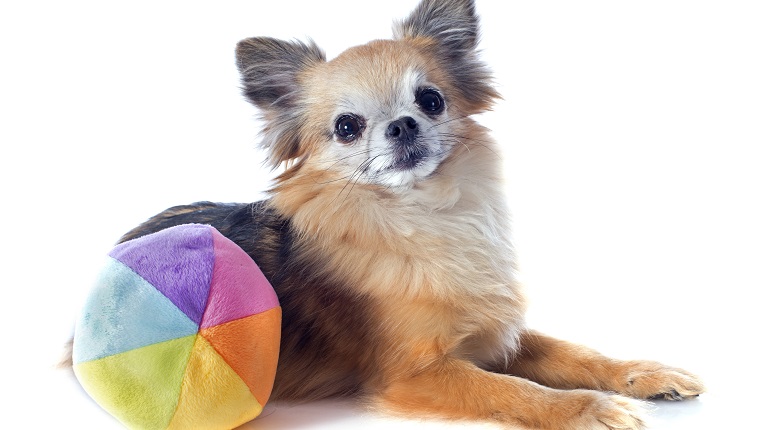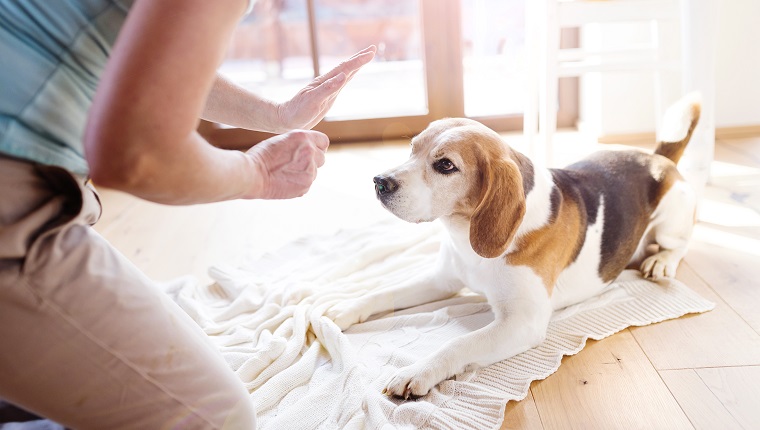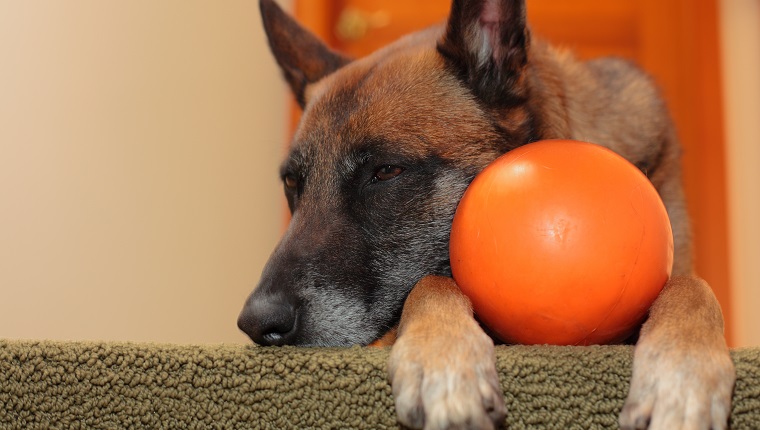In our Gold Souls, Gray Faces series, we discuss the special care our sweet senior dogs need to stay healthy and happy. Your lovable, gray-faced, senior pooch may not move as fast in their old age as they used to, but that doesn’t mean they have no need for exercise.
In fact, it’s very important that seniors maintain mobility and a healthy weight to avoid putting extra stress on their old bones and joints. Exercise also helps prevent conditions like heart disease or diabetes that often come with obesity.
Maybe your senior dog is having trouble handling the weather these days, but there are plenty of indoor exercises that will help keep them in shape.
Before you start, remember to ask your veterinarian if your dog is healthy enough for mild exercise, and work with your vet to decide what is an appropriate amount of physical activity for your senior. Never push your old dog past their comfort, and if they want to stop exercising at any time, allow them to rest and relax.
Once you get the green light from the vet, give these six low-stress, easy exercises a try.
1. Puzzle Feeders
Consider getting a puzzle feeder for your old dog.
These toys provide a mentally stimulating challenge that can help keep your senior’s brain active and sharp, as well as providing them with the opportunity to move around. The physical requirements for these toys shouldn’t be too high.
Providing your senior dog with meals via a puzzle feeder will also help your dog to slow down while eating, which will further promote weight loss if that’s one of your goals. Stick to toys that don’t require a lot of physical strength to use, as you don’t want to overexert your pup.
The classic Kong is always a good option, though there are tons of other puzzle feeders on the market that you should check out. Find a few that are appropriate for your dog’s activity level.
2. Fetch On The Carpet

Fetch never goes out of style, but it can be more difficult when you’ve got sore joints and bones.
Indoor fetch on a rug or carpet is probably better for your old dog because they can more easily maintain their footing and not have to worry about falling down and getting hurt so much.
Use a soft item that won’t put stress on their teeth. There are several toys specifically designed for older dogs that are nice and soft. Stick to short, low tosses so your dog doesn’t have to run, jump, or go too far.
Remember, this isn’t meant to necessarily challenge your dog; it’s just meant to get them moving and provide some activity to stay in shape. Give them plenty of water when you’re done playing, and don’t push them to keep going when they start to pant or get tired.
3. Gentle Tug-Of-War
Tug-of-war may have been one of your dog’s favorite games throughout their life, and there’s no reason you can’t still play.
In fact, the act of pulling is a great workout that gets many of your dog’s muscles working together. It can help strengthen the neck, jaws, and shoulders.
Use a soft item that won’t put stress on their teeth. Remember that you can’t play as rough as you used to, so no swinging or hard tugging, which can cause dental and muscle injuries. Let your old pup win once in a while to help instill them with confidence.
Depending on what kind of toy you use, this game can also provide your dog with a light flossing action that may improve teeth and gum health.
4. Stretches And Physical Therapy
If your dog is having some joint problems, you may wish to consult a physical therapist to improve their condition.
A physical therapy session may involve massages, stretches, and hydrotherapy, but you will also likely get instructions for at-home workouts to keep up with care. This is especially important if your dog has trouble with mobility because muscles, joints, and ligaments still need to move to stay healthy.
Proper stretches can help to get joint fluid warmed up and moving, improve blood flow, and make joints and muscles feel more relaxed and comfortable, but you should never push a senior dog to the point of discomfort. Stretching can improve a dog’s gait, allowing them to walk more easily and become more active.
There are several stretches you can do at home, but it is best to consult a professional before you begin so that you don’t put too much stress on your dog and cause further issues.
5. Find It
“Find it” is a fun game for dogs of any age that provides a mental and physical workout. All you really need to do is hide some treats around a room and allow your dog to sniff them out.
If you’ve never played before, you may need to help guide your senior dog to the treats for the first few times. Eventually, they should be able to follow their nose to get the goods.
You can also hide their meals in small amounts to slow down their eating, but if they start to feel tired, don’t push them. Make sure you hide the treats low to the ground and in a relatively small area so they don’t have to go far.
This should be a fun exercise that’s not too challenging, but it will get your dog using their brain and body.
6. New Tricks

You may have heard the phrase, “You can’t teach an old dog new tricks.” That’s not true at all, and we should give our seniors a little more credit. They just require a bit more patience, but learning new things can work out the mind and the body.
Of course, you won’t want your senior to have to do anything too physically demanding, but there are plenty of tricks that don’t require much movement.
Balancing a treat on their nose, walking between your legs, or just doing some of the basics your pup may have missed or forgotten over the years can be a nice workout and a rewarding experience that will let your dog know they can still please you, even in their old age.
Keep training sessions short enough to avoid exhaustion, and pay attention to your pup’s needs. Give them lots of love for doing what you ask, and there’s no harm in giving them lots of love even if they don’t figure it out. At this age, you can just be happy when they get moving and make an effort.
Have you tried any of these exercises before? What other indoor exercises do you like to do with your senior dog? Let us know in the comments below!
Click the bold links in the article to shop for your dog and support our content!









